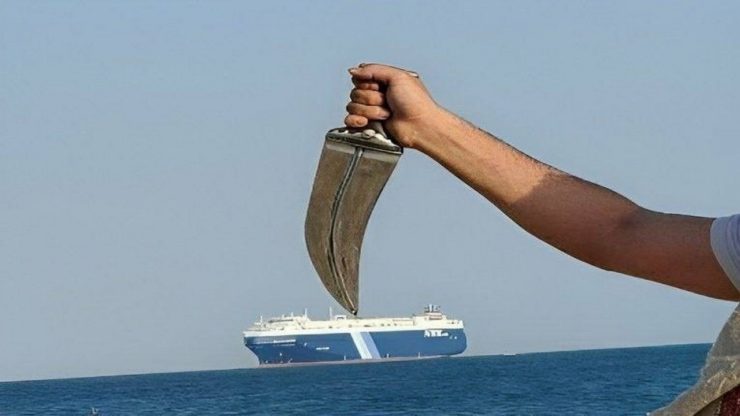
Following the declaration of Yemen’s Houthis that they will attack any (cargo) ships travelling to Israel, the Red Sea region has become the latest flash point of yet another military conflict following the ones that are ongoing in Eastern Europe and the Middle East. In fact, Houthi attacks appear to be a direct outcome of Israel’s war on Palestine. Since the group is part of what is more commonly known as the “axis of resistance” against Israel and the US, most analysts in the mainstream Western media seem to simply associate the Houthi action with their bid to support Hamas against Israel. To an extent, this is true. But there is another dimension that would explain why the Houthis, out of everyone else based in the region and perfectly capable of conducting similar action, decided to launch these attacks.
The Houthi war on Israel is mainly a reaction against Israel’s, in alliance with the UAE, occupation of Yemen’s Socotra island – a piece of land that the UAE, taking advantage of the political situation caused by the US-supported Saudi and UAE war on Yemen, occupied in 2018. Now, Israel, in alliance with the UAE, is building a military base on the Island to exercise military control over maritime routes in the Red Sea region and conduct intelligence operations against Iran. This base, according to reports in the media, will house Israeli military and intelligence officers. In January 2022, reports of Israeli “tourists” visiting the Island using visas issued by the UAE emerged in the media, showing the ongoing cooperation between the two states.
This military base is part of Washington’s bid to create the ‘new’ Middle East in which Israel, in alliance with Gulf states, would play the same role that Washington played for decades to counter Iran. While Israel’s war on Gaza has complicated the possibility of a grand Arab-Israel normalization, the military base remains a parallel process that not only divests Yemen of its territory and compromises its sovereignty but also threatens Iran directly. Therefore, Houthi attacks in the Red Seat targeting Israel make military sense.
More important, however, is Washington’s response to it. In this response, Washington, instead of pushing for resolving the cause of the conflict, i.e., an Israeli-UAE occupation of the island, is bringing the QUAD – a security alliance comprising the US, India, Japan, and Australia – to the Red Sea to combat Houthi “terrorism”.
In the inaugural meeting of the QUAD working group on terrorism held in Hawaii on December 19-21, the group decided to “explore cooperation amongst the Quad, and with Indo-Pacific partners, to counter new and emerging forms of terrorism, radicalisation to violence and violent extremism”. Making an indirect reference to the Houthis, the statement also said, “We note with deep concern that terrorism has become increasingly diffuse, aided by terrorists’ adaptation to, and the use of emerging and evolving technologies such as unmanned aerial systems (UAS) and the internet, including social media platforms for recruitment and incitement to commit terrorist acts, as well as for the financing, planning, and preparation of terrorist activities”.
Pushing the QUAD to the Red Sea is, in simple words, a plan to militarise the region to protect Israeli interests and undermine those of its rival states, especially Iran. There is no denying that Israel – and the US – have been making their ‘naval moves’ in the region for more than two years now. Now that Israel is facing an ever-increasing threat and that its war on Gaza is threatening to spill over, Washington’s timely move to introduce the QUAD in the Red Sea makes perfect geostrategic sense.
But Washington is not simply protecting Israel. Washington’s presence in the region via both the Israeli base and the QUAD is also targeted at China, which already has a military base in Djibouti. In that sense, the QUAD’s move into the Red Sea is part of its expansion from an alliance hitherto focus on the Pacific Ocean to the Indian Ocean, bringing the great power rivalry from one region to another region. This is a response to China’s continuous success in pushing against the US across the world.
In its 2023 report on the challenges that China is posing to the US dominance in the world, the Pentagon said that,
“The PRC [People’s Republic of China] employed a wide range of diplomatic tools throughout 2022 to erode U.S. influence globally and subvert U.S.-backed security partnerships such as the Quad and AUKUS … PRC leaders and officials have increasingly sought to bolster the PRC’s relations with developing countries in Africa, Southeast Asia, and the Middle East; co-opt regional multilateral organizations such as ASEAN; and assert its status as the self-appointed de facto leader of the “Global South.”
Washington obviously wants to challenge PRC and limit the possibility of its expansion. To what extent it can actually do this is a moot question, however. Where Washington’s own limitations are strikingly evident in bring the QUAD to the Red Sea region is that the QUAD does not have any regional partner, e.g., Saudi Arabia or any other Red Sea state, willing to tackle China. China, on the other hand, does have very strong economic ties with many states in the region, which means that the Red Sea states are by default unwilling to jump on Washington’s bandwagon to ‘counter’ China.
However, the fact that Washington is pushing for a further militarization of the region, rather than helping resolve existing and potentially new conflicts, vividly reflects its priorities: it wants to spread conflict and use the scenario to further its own regional and global geostrategic interests.
Salman Rafi Sheikh, research-analyst of International Relations and Pakistan’s foreign and domestic affairs, exclusively for the online magazine “New Eastern Outlook”